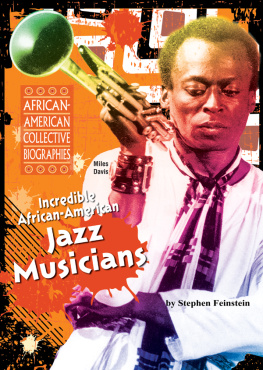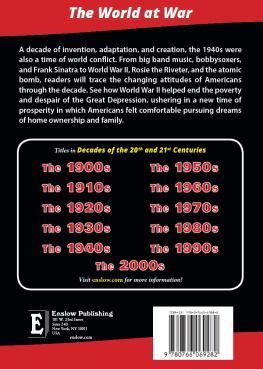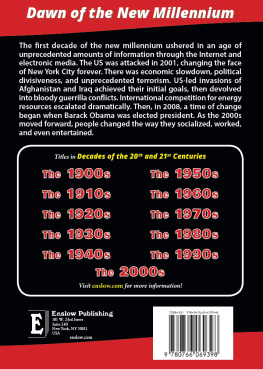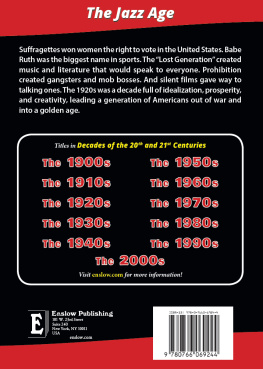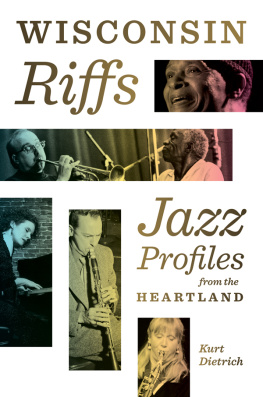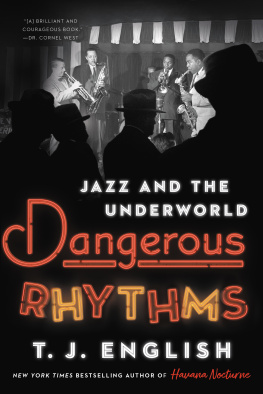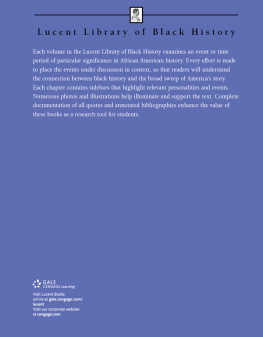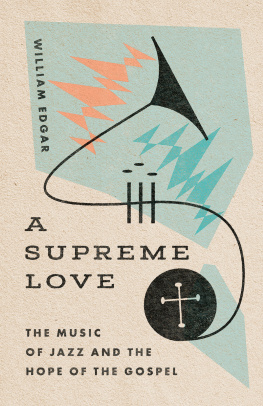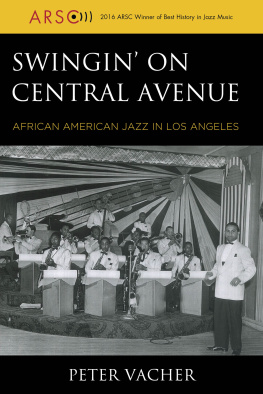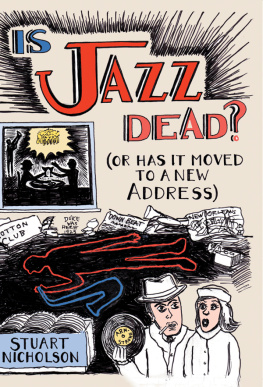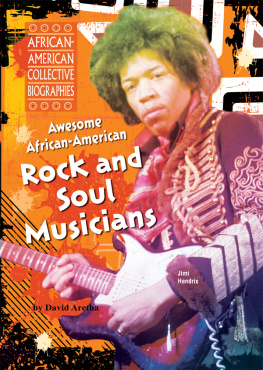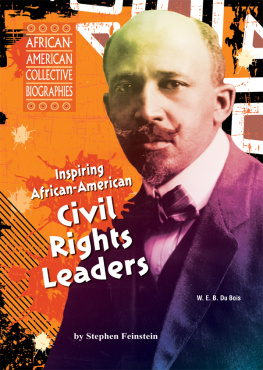Jazz!
Jazz is the only art form invented in America. Incredible African-American Jazz Musicians profiles eight of the greatest jazz artists, from Louis Armstrong to Herbie Hancock. Learn how these musicians got started and what gifts they brought to the world of music.
Stephen Feinsteins book is an excellent introduction for young readers to the amazing lives of some of Americas greatest musicians.
Burton Peretti, PhD
About the Author
Stephen Feinstein is a writer of educational materials, specializing in social studies and language arts. Another of his books for Enslow Publishers, Inc., is Read About Jackie Robinson.
Jazz is the first art form invented in America. Created mainly by poor black men and women, it was African Americans gift to the world. According to writer Gerald Early, jazz is one of Americas most important contributions to world culture. Early wrote, I think there are only three things that America will be known for two thousand years from now: the Constitution, jazz music, and baseball, the three most beautifully designed things this country ever produced.
Jazz did not just appear out of the blue. It is not as if a very clever musician sat down one day and came up with a brand-new type of music. Jazz grew out of a combination of elements from earlier forms of African-American music and European musical traditions. Chief among these were ragtime and the blues. Ragtime had its origins in the 1880s. It was an African-American musical form featuring syncopated rhythms. The name ragtime literally means ragged time. It came from the musics ragged rhythms, or syncopation. In music that has syncopation, players put accents or emphasis on the weak beat, or just before or after the beat.
Compared to European music, according to author James Haskins, ragtime
was closer to the rhythms of the black dancers who used their heels to make drum sounds, or to that of the black church singers who could vary the rhythms of a Christian hymn so much that a white Christian could not even recognize it. It was also related to the call-and-response pattern of Negro work songs and to the percussive rhythms of the banjo and the bones.
(The bones were actually animal bones that had been cleaned and allowed to dry white in the sun. When played, the bones made a clackety-clack sound to accompany the drum.)

Image Credit: Courtesy of Stephanie Fryer
Music for Scott Joplins hit, Maple Leaf Rag, one of the most popular rags ever written. Many people consider ragtime to be the first jazz.
African-American pianist-composer Scott Joplin (18681917) became the best-known ragtime composer. His Maple Leaf Rag, written in 1899, became Americas most popular piano rag. Joplin came to be called the Ragtime King. Pianist Eubie Blake (18831983), another major ragtime musician, composed, played, and recorded ragtime until late in his life.
Many contemporary music historians consider ragtime to be the first jazz music. But others disagree. Ragtime had the syncopated rhythmic patterns of jazz. But it lacked other elements typical of most jazz music, mainly the blues, swing, and improvised solos.
Since the days of slavery, African Americans in the South had been singing songs of sorrow, loneliness, defiance, and humor. According to James Haskins, the blues were derived from these earlier types of songs:
Like the sorrow songs of the earlier plantation slaves, the blues represented the cries of people who had nothing, who seemed to get nothing no matter how hard they tried, and whose lives seemed hopeless. By this time, such songs were often sung in lively rhythmslike laughing to keep from crying.
The typical format of a blues song was a twelve-bar melody consisting of three different chords. Each bar, or measure, had a fixed number of beats, usually four. Usually, within the twelve bars, a line of music or lyrics was repeated twice, with a closing line contrasting to the first two. Blues is the most basic structure for improvising in jazz. Improvisation is the spontaneous creation of melodies and rhythms. When playing a jazz tune, which may or may not be a familiar song, the player uses the given melody and chord changes as a framework and starting point for exploring the possibilities of the song. As much as half of a jazz performance may be created on the spot.
Jazz is said to swing when the strong beat, through the use of syncopation, bombards the listener. Jazz music is characterized by the swing feel. As if to announce this fact to the world, the great jazz composer Duke Ellington wrote a song called It Dont Mean a Thing (If It Aint Got That Swing). Indeed, some believe that the term swing originated with that hit tune.
The greatest jazz musicians each had their own voice, sound, or style of playing. Miles Davis played trumpet in a muted whisper. Charlie Parkers saxophone solos displayed phenomenal speed and variety. According to writer Grover Sales, jazz soloists must improvise at breathtaking tempos that would challenge, and on some instruments excel, the technique, let alone the imagination, of top symphony musicians. That is why jazz improvisation requires a high level of technical and creative ability.
The earliest jazz originated in New Orleans. Its musical elements were derived from African-American brass marching bands and ragtime music from the saloons. Known as Dixieland, it was characterized by several musicians simultaneously playing their improvisations based on the melody and chord pattern of the tune. The tune would most likely have been a popular song of the day or a blues that the musicians did not compose. Many of these early jazz musicians could not read music. But through improvisation they created exciting, joyful music that bore little resemblance to the original tune.
Among the first African-American jazz players were musicians such as Buddy Bolden, Freddie Keppard, Bunk Johnson, and Clarence Williams. Most of these men could not earn a living with their music and were forced to work at menial jobs to get by. A second wave of New Orleans jazz musicians including Joe King Oliver, Kid Ory, and Jelly Roll Morton developed the music further and gained greater commercial success than the older players.

Image Credit: Everett Collection
The Preservation Hall Jazz Band in New Orleans, photographed in the 1960s. This group plays Dixieland, an early type of jazz.
Jazzs first important soloists, such as King Oliver and Louis Armstrong, began their careers improvising in these popular Dixieland bands. The music they played was mostly party music, music made for dancingas jazz would be for many years to come.
Ironically, although African-American musicians laid the groundwork, the all-white Original Dixieland Jass Band (ODJB) made the first jazz record. In 1917, ODJB recorded Livery Stable Blues.
During the 1920s, the center of jazz innovation and excitement migrated from New Orleans to Chicago. That citys bustling clubs and recording studios gave jazz musicians a route to national recognition. Trumpeter Louis Armstrong became jazzs first famous soloist. Because he was such a brilliant improviser, Armstrong brought about a new approach to jazz. Instead of the Dixieland style of group improvisation, now each musician took a solo so that the audience could more fully appreciate and enjoy the creativity and skill of the individual musicians. By the late 1920s, New York had become the heart of the music industry. And by the end of the decade, jazz was a part of Americas national culture.

